#Nicaean Empire
Explore tagged Tumblr posts
Text

Et voila! I know you’ve all been waiting for it 🤭🤭
#byzantium#byzantine empire#byzantine empress#theodora palaiologina#anna of savoy#maria of trebizond#nicaean empire#empire of nicaea#13th century#14th century#15th century#history art#digital art#pride#lesbian#trans pride#pride art#greek tag#roman tag#italian tag#german tag#rus tag#bulgar tag#outremer#hungary tag#armenia tag#france tag
16 notes
·
View notes
Text

Irene Doukaina Laskarina was empress consort of Bulgaria (1258–1268). She was the second wife of Tsar Constantine Tikh of Bulgaria.
She was a daughter of Emperor Theodore II Laskaris of Nicaea, and his wife Elena of Bulgaria, and sister of Nicaean Emperor John IV Laskaris. Her maternal grandparents were Tsar Ivan Asen II and Anna Maria of Hungary.
In 1257, Irene married Bulgarian nobleman Constantine Tikh as his second wife. Her husband was a pretender to the Bulgarian crown. Constantine was proud to be married to a granddaughter of Tsar Ivan Asen II, and he adopted the Bulgarian dynastic name Asen to enhance his claim to the crown. In the next year Constantine was elected Tsar of Bulgaria by a boyar council in Tarnovo and Irene become his consort.
In 1261 Irene's young brother, Emperor John IV Laskaris, was deposed and blinded by Nicaean regent Michael VIII Palaiologos, who had just regained Constantinople from the Latin Empire, re-establishing the Byzantine Empire. Tsaritsa Irene was a bitter enemy of the usurper. She became a leader of the anti-Byzantine party in the Bulgarian court.
Irene died in 1268. She had no children.
2 notes
·
View notes
Text
History in the Style of Dave Attell
The Fall of Constantinople (Part 1)
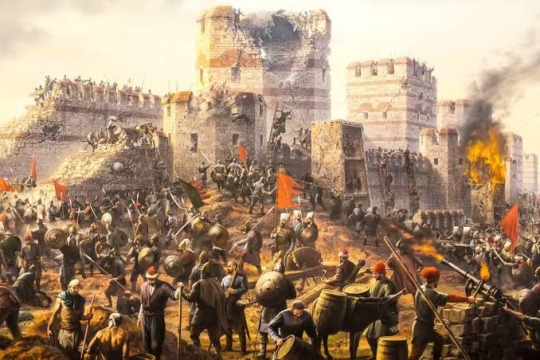
Ok, kiddos. Today we are talking about the Fall of Constantinople. Oh yeah that Fall. The big one, like when your grandmother fell on the ice back in 92. Except no one’s laughing this time.
So, there was this big siege back in 1453, and let me tell ya, it was a wild ride. The Ottoman Empire was all like, "Hey, we wanna take Constantinople," and the Byzantine Empire was like, "Nah, man, we're not giving it up that easily." But here's the thing, the Ottomans had this secret weapon called gunpowder, and they were blasting massive cannon balls at the walls of Constantinople. These walls, mind you, were no joke. They were some of the most fortified and advanced in the ancient and medieval era, but even they couldn't withstand the power of those Ottoman cannons. Eventually, after a 53-day siege, Constantinople fell, and boom, the Ottoman Empire had their new capital. It was a major turning point, marking the end of the Byzantine Empire and the medieval period. Boo hoo. No more medieval period. You’ve been squiring around with that knight for nothing.
Anyways…
Now, here’s some background to the going onzies in the Byzantine Empire
Alright folks, let me break it down for you. We're talking about the Byzantine Empire here, the good ol' Constantinople. This place had been through some serious shit, let me tell you. It had been besieged so many damn times, it's a wonder it didn't have a permanent "Closed for Renovations" sign hanging on its gates. But guess what? Those crusaders couldn't resist the temptation, and in 1204, they stormed in and had themselves a nice little party, known as the Sack of Constantinople. They set up their own Latin "state, while the rest of the Byzantine Empire fractured into a bunch of squabbling successor states. It was chaos, my friends. But don't worry, the Nicaeans came to the rescue, conquering Constantinople back from the Latins in 1261. They reestablished the Byzantine Empire, but let me tell you, it wasn't all sunshine and rainbows. The empire was on the brink, constantly defending itself against the Latins, Serbs, Bulgarians, and those damn Ottoman Turks. And if things couldn't get worse, the Black Death decided to pay a visit, wiping out half the population between 1346 and 1349. By 1453, the once mighty empire was reduced to a few measly villages surrounded by fields, all guarded by those ancient Theodosian Walls. The grandeur was long gone, my friends. It was a sad sight to behold. So there you have it, the sorry state of the Byzantine Empire. Tough times, my friends. Tough times indeed.

So now let’s turn our attention to Sultan Mehmed the second. He’s the man - the man that conquered Constantinople.

Alright, so we've got Sultan Mehmed II, this young badass at only 21 years old, ready to take world. Europe thought he was a rookie, a pushover, so they partied it up when he took the throne. Mehmed even sent the Europeans presents. But little did they know, Mehmed wasn't just all talk. He started building fortresses left and right, control of the Bosphorus and protecting against any Genoese troublemakers. He wasn't messing around. And guess what? He even sent a garrison to block Constantine XI from getting any help down in Greece. Meanwhile, he had his boys fixing up the roads and bridges, making sure they could handle the cannons he had planned for Constantinople. Sultan Mehmed II was a force to be reckoned doubt about it.
0 notes
Text
Events 7.25 (before 1900)
306 – Constantine I is proclaimed Roman emperor by his troops. 315 – The Arch of Constantine is completed near the Colosseum in Rome to commemorate Constantine I's victory over Maxentius at the Milvian Bridge. 677 – Climax of the Siege of Thessalonica by the Slavs in a three-day assault on the city walls. 864 – The Edict of Pistres of Charles the Bald orders defensive measures against the Vikings. 1137 – Eleanor of Aquitaine marries Prince Louis, later King Louis VII of France, at the Cathedral of Saint-André in Bordeaux. 1139 – Battle of Ourique: The Almoravids, led by Ali ibn Yusuf, are defeated by Prince Afonso Henriques who is proclaimed King of Portugal. 1261 – The city of Constantinople is recaptured by Nicaean forces under the command of Alexios Strategopoulos, re-establishing the Byzantine Empire. 1278 – The naval Battle of Algeciras takes place in the context of the Spanish Reconquista resulting in a victory for the Emirate of Granada and the Maranid Dynasty over the Kingdom of Castile. 1467 – The Battle of Molinella: The first battle in Italy in which firearms are used extensively. 1536 – Sebastián de Belalcázar on his search of El Dorado founds the city of Santiago de Cali. 1538 – The city of Guayaquil is founded by the Spanish Conquistador Francisco de Orellana and given the name Muy Noble y Muy Leal Ciudad de Santiago de Guayaquil. 1547 – Henry II of France is crowned. 1554 – The royal wedding of Mary I and Philip II of Spain celebrated at Winchester Cathedral. 1567 – Don Diego de Losada founds the city of Santiago de Leon de Caracas, modern-day Caracas, the capital city of Venezuela. 1593 – Henry IV of France publicly converts from Protestantism to Roman Catholicism. 1693 – Ignacio de Maya founds the Real Santiago de las Sabinas, now known as Sabinas Hidalgo, Nuevo León, Mexico. 1718 – At the behest of Tsar Peter the Great, the construction of Kadriorg Palace, dedicated to his wife Catherine, begins in Tallinn. 1722 – Dummer's War begins along the Maine-Massachusetts border. 1759 – French and Indian War: In Western New York, British forces capture Fort Niagara from the French, who subsequently abandon Fort Rouillé. 1783 – American Revolutionary War: The war's last action, the Siege of Cuddalore, is ended by a preliminary peace agreement. 1788 – Wolfgang Amadeus Mozart completes his Symphony No. 40 in G minor (K550). 1792 – The Brunswick Manifesto is issued to the population of Paris promising vengeance if the French royal family is harmed. 1797 – Horatio Nelson loses more than 300 men and his right arm during the failed conquest attempt of Tenerife (Spain). 1799 – Napoleon Bonaparte defeats a numerically superior Ottoman army under Mustafa Pasha at the Battle of Abukir. 1814 – War of 1812: An American attack on Canada is repulsed. 1824 – Costa Rica annexes Guanacaste from Nicaragua. 1837 – The first commercial use of an electrical telegraph is successfully demonstrated in London by William Cooke and Charles Wheatstone. 1861 – American Civil War: The United States Congress passes the Crittenden–Johnson Resolution, stating that the war is being fought to preserve the Union and not to end slavery, in the wake of the defeat at the First Battle of Bull Run. 1866 – The United States Congress passes legislation authorizing the rank of General of the Army. Lieutenant General Ulysses S. Grant becomes the first to be promoted to this rank. 1868 – The Wyoming Territory is established. 1869 – The Japanese daimyōs begin returning their land holdings to the emperor as part of the Meiji Restoration reforms. (Traditional Japanese Date: June 17, 1869). 1894 – The First Sino-Japanese War begins when the Japanese fire upon a Chinese warship. 1897 – American author Jack London embarks on a sailing trip to take part in the Klondike's gold rush, from which he wrote his first successful stories. 1898 – Spanish–American War: The American invasion of Spanish-held Puerto Rico begins, as United States Army troops under General Nelson A. Miles land and secure the port at Guánica.
0 notes
Text
actually the real successor to rome was the latin empire. down with the nicaean empire!

I've been saying this for years
102 notes
·
View notes
Text
Identifying Marks of Celtic Christianity
According to Timothy Joyce, OSB, the following tendencies are among the marks of the Celtic Church from its earliest conception. A Trinitarian Emphasis: Celtic gods were known for their variable forms and polymorphic symbolism, and the Celts themselves had a strong association between the number 3 and the numinous. This made them quite amenable to the Christian Trinitarian doctrine, and “this Trinitarian consciousness permeated Celtic spirituality.” In addition to this special attention to the Trinitarian dimension of God, this tenderness towards threeness also affected the form of prayer; whereas Hebrew poetry often has “double segmentation,” in which an idea is expressed in two lines using different phrasing, “a triad way of expressing prayer” became common in the Celtic Church. A Emphasis on Saintly Heroism: Celts were known, at least in Roman sources, as passionate and frightening warriors. Celtic pagan literature, as preserved by Christian sources, is replete with martial heroes. This fascination with heroic figures remains in Celtic Christianity, where feelings of devotion are transferred to Christ, Conqueror of death, as well as saints. Hagiographic literature is interested in miraculous occurrences, but stories of extreme penances are also very prevalent; the heroic ascetic who conquers the world, the flesh, and the devil is the archetype that appears the most important in Celtic hagiographies. There is thus also a reverence accorded to priests and other consecrated religious that wasn’t quite as strong in, for example, English churches. A Non-Diocesan Social Organization: Especially in Ireland, but in other parts of the Celtic world as well, Christianity spread and developed outside the direct influence of the Roman Empire. Whereas the Roman Catholic Church was organized primarily in the image of the Empire itself, in city-based dioceses that ruled surrounding areas, the Celtic Catholic Church’s major centers of influence were monasteries that dotted the countryside. As such, the Celtic Catholic Church was less centralized than its continental counterpart. There was a more synodal structure to the Celtic Catholic Church, an emphasis on existence as “a local church that was in communion with all other local churches forming the universal church with the bishop of Rome, who enjoyed a special ministry of primacy.” An Eastern Influence: Though in contact with the Roman Church, the Celtic Church also reveals influences from the other Apostolic Sees; the acsetic spirit already spoken about shows clear inspiration from the Desert Fathers, and the works of John Cassian (who would also influence Benedictine spirituality) made their way to the British Isles through his disciple, Saint Illtyd. The theology of Saint Irenaeus, himself a disciple of Polycarp of Smyrna (in Asia Minor), proved to be very congruent with pre-Christian Celtic spiritualities. In particular, Irenaeus’s focus on the sanctification of human life and material things through God’s decision to become material Himself resonated very well. An Awe for the Created World: The sacramental worldview that is the hallmark of all pre-Reformation Nicaean Christians is even more explicitly expressed in the Celtic Church; experiencing God through natural phenomena seems to have been commonplace in this Church, with an emphasis on dreams and experiencing the numinous in nature. In addition to physical church buildings, shrines and altars could be found in “thin places,” locations that could be interpreted as either places where the boundaries between this world and the next were weaker, or where the natural sacredness of the world was more resonant with the human senses. Islands, shores, and mountains were all seen as “naturally sacred by their very essence,” but “cemeteries. [...] ring-forts, and mounds in a field,” as well as sacred wells, were also such places. These places were not necessarily unambiguously good, though; there is a certain ambivalence in this sacredness, which in this sense means “set apart” rather than “holy” as it is traditionally understood: “Prayers of praise were common but prayers of protection from the dark side of the unknown were also part of this spirituality.” Source: Celtic Christianity: A Sacred Tradition, A Vision of Hope
164 notes
·
View notes
Photo
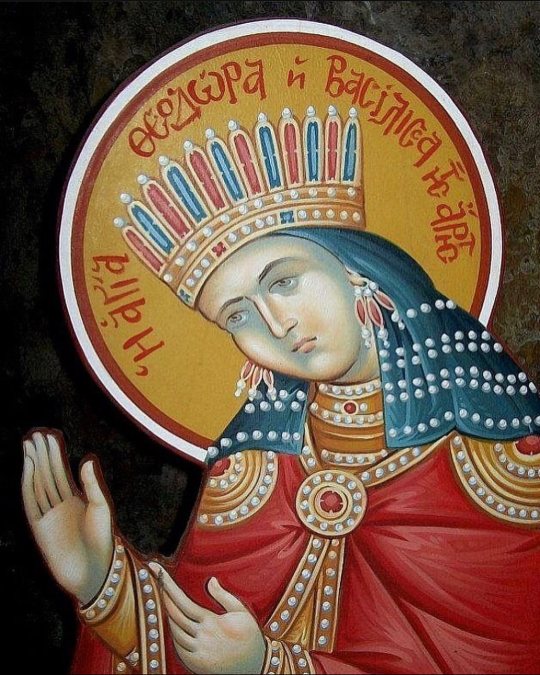
Today we also celebrate the Holy Queen Theodora of Arta. Theodora was born in Thessaloniki sometime between 1210 and 1216, and married Michael II Komnenos Doukas, the ruler of Epirus and Thessaly shortly after his accession in 1231, while still a child. Despite her being pregnant with Michael's son Nikephoros, she was soon banished from the court by her husband, who preferred to live with his mistress. Living in poverty, she endured her hardship without complaint, sheltered by a priest from the village of Prinista. Her exile lasted for five years, after which Michael repented and called her back to him. The couple thereafter lived together. As consort of Epirus, Theodora is reported to have favoured closer ties with Epirus' traditional rival for the succession of the Byzantine imperial heritage, the Empire of Nicaea. She is also recorded by the contemporary historian George Akropolites as accompanying her son Nikephoros for his betrothal and later his marriage to Maria, the daughter of the Nicaean emperor Theodore II Laskaris (r. 1254–1258). The rapprochement brought about a settlement of the two realms' ecclesiastical disputes and led to the conferment of the title of despotes on Michael, but did not last long. Theodora also founded the convent of St. George in the Epirote capital, Arta, where she retired after Michael's death, and where she was buried. It later became known as the Church of St. Theodora, and her tomb became the site of pilgrimage, as many miracles have been attributed to it. May she intercede for us always + Source: https://en.m.wikipedia.org/wiki/Theodora_of_Arta (at Megalóchari, Arta, Greece) https://www.instagram.com/p/Ca8F_prvaUV/?utm_medium=tumblr
17 notes
·
View notes
Quote
The earlier Turks, who came largely by way of Persia, with a period of settlement in that country, belonged to the great Seljuk movement. They were nominally Moslems, and very quickly became an indigenous element, because they had settled themselves permanently in every place that had been opened up to Turkish immigration by the Seljuk armies. So firmly rooted did they become that, when the fortunes of war allotted again temporarily some of the places which they inhabited to the Crusaders and to the Nicaean Byzantines, they did not dream of moving out. This was the best country they had ever seen and they had no intention of leaving it. When the Osmanlis captured Brusa and Nicaea, they found many Moslems who had been there for three generations. Simple-minded, tolerant of others, totally unconscious of the privileges as well as of the obligations of an organized society, the Turks of the earlier immigration neither opposed nor aided in the political changes which have so frequently been the lot of Asia Minor since their coming. This holds true of the Anatolian Turks of the present day, and will be so as long as they remain illiterate and uninstructed.
The Foundation of the Ottoman Empire; a history of the Osmanlis up to the death of Bayezid I (1300-1403)
Gibbons, Herbert Adams, 1880-1934
https://www.gutenberg.org/ebooks/56836
2 notes
·
View notes
Note
Easter was started in 325 by the Council of Nicaea. Christians who pay attention to the boring history bits might recognize this as the council that defined what a Christian is with the advent of the Nicaean Creed.
After the first few books of the New Testament that chronicle the life and teachings of Jesus most of the rest of the new testament is about the early church differentiating itself from the practice of Judaism and a lot of trial and error in power structures and over-reach as they tried to learn to love like Christ. The Gospel was meant for every Tribe and Nation and Tongue and the very first hurdle was learning to accept gentiles and letting go of the Jewish Law from the old-testament (Note: American Evangelicals work very very hard to avoid most of the rest of the New Testament with the exception of Titus 2 and several other favored passages, instructions about the acceptable and unacceptable behavior of the church are very inconvenient to western power structures.) the long and short of it is that by the 300s the church was spread throughout the Roman Empire and really didn’t care about the Jewish calendar at all.
Most of our modern holidays commemorate specific historical events. We observe chosen anniversaries. It’s natural for us to assume that the historicity was central to the decision.
Holidays at the time were more metaphorical observations. Set aside time to reflect on a concept and honor a deity. They did it in a matter similar to many of the contemporary pegan practices; based on the solar and lunar calendars (and also badly.)
It was decided Easter would be the First Sunday after the first full moon after the vernal equinox. (This resulted in more conflict as Eastern and Western churches disagreed about how to calculate the vernal equinox)
I think people from a Christian background probably think Easter is a Jewish holiday because it's so tired to Passover in Christian tradition. According to the Christian Bible, Jesus was betrayed during a Passover sedar. So I think they probably think something like Jesus was Jewish, he was celebrating a holiday, we celebrate Easter, so Easter must be a Jewish holiday.
lemme see if I can parse this out; my brain is on standby mode rn.
Step one: jesus is jewish. Okay, got that.
Step two: he was betrayed during a passover seder. I've heard this said a lot, but I've never seen any proof? Idk I'll look it up later, people have probably given it a lot of thought.
Step three: this is where I'm getting lost. Why is easter tied to pesach? What happened on easter that people attach it to pesach?
Step four: jesus celebrated pesach (still don't get how it's tied to easter!) And that's why easter is jewish?
Huh?
I think I had someone tell me that pesach is translated in Spanish as "jewish easter" so I thought THAT was where the confusion came from.
Also all the pesach appropriation but like. Yeah.
11 notes
·
View notes
Photo










Byzantine Imperial Family & House of Babenberg: Princess Eudokia Laskarina of Nicaea
Eudokia was born to Emperor Theodora I Laskaris of Nicaea and his wife Anna Komnene Angelina. Eudokia is sometimes also called Sophia. Her siblings were Nicholas and John Laskaris as well as Empress Irene Laskarina of Nicaea and Queen Maria of Hungary. Eudokia’s mother Anna Kommene Angelina was a first cousin to German Queen Irene and a relative of unknown degree to Duchess Theodora Angela of Austria.
Her childhood was a turbulent one as her father tried to secure control over the newly established Nicaea. When he died in 1222, her brother-in-law became the new emperor. But her uncles fought his claim and kidnapped Eudokia. She was brought to Constantinople where her uncles wanted to marry her Latin Emperor Robert I who had promised his support to them in the fight for the Nicaean throne. But the Patriach Manuel of Nicaea denied this marriage due to their close kinship. Technically they weren’t related by blood but Robert’s sister had been the third wife of Eudokia’s father. Eudokia remained in Constantinople.
In 1229, Eudokia’s life changed again when she married Hereditary Duke Frederick II of Austria & Styria. Frederick himself had a Byzantine mother and great-grandmother, Theodora Angela. Furthermore, Frederick’s father wanted to protect the border to Hungary of which Eudokia’s sister was the queen, making the Hungarian King and his son and heir brothers-in-law. But the marriage between Frederick and Eudokia did not last long. He married Agnes of Merania the same year.
What happened to Eudokia afterwards is unknown. She only reappears when she marries Anseau de Cayeux, the regent of the Latin Empire. But when exactly this marriage was contracted is widely debated. The earliest date is just a year after her divorce, the latest 1239.
Eudokia died some time during 1247 and 1253. Her place of burial or cause of death are unknown.
// Öyku Karayel in Magnificent Century: Kösem (2015-17)
#historyedit#byzantine empire#Austrian history#women in history#European history#middle ages#13th century#1200s#Eudokia of Nicaea#Eudokia of Byzantium#House of Babenberg#Byzantine History#Byzantine princess#Eudokia Laskarina#Laskaris family#German history#Hereditary Duchess Eudokia of Austria & Styria
130 notes
·
View notes
Photo
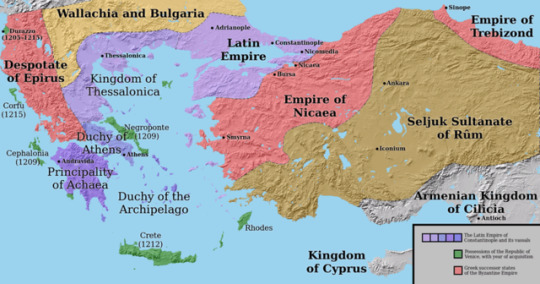
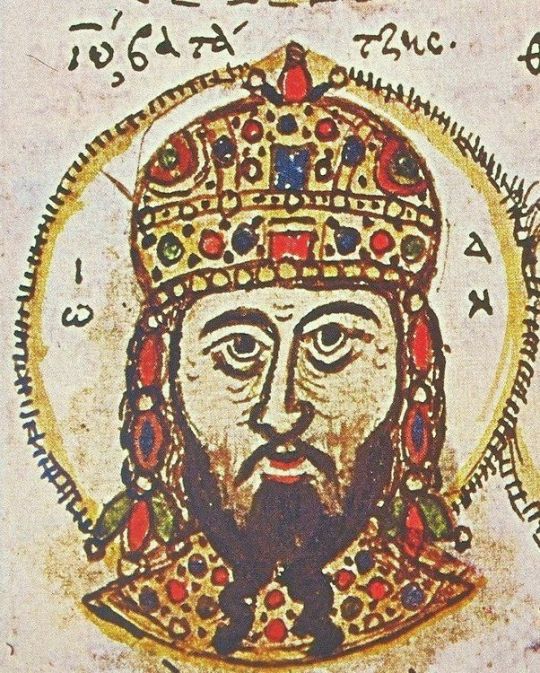
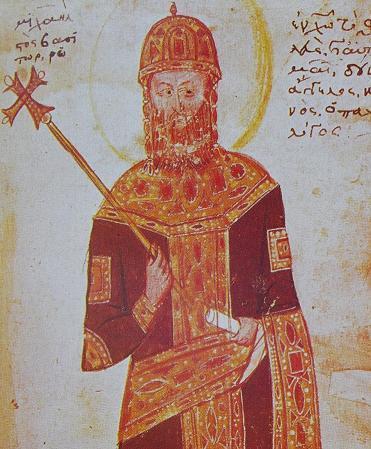
EMPIRE OF NICAEA:
THE Empire of Nicaea was a successor state to the Byzantine Empire, or rather a Byzantine Empire in exile lasting from 1204 to 1261 CE. The Empire of Nicaea was founded in the aftermath of the sacking of Constantinople during the Fourth Crusade and the establishment there of the crusader-run Latin Empire in 1204 CE and was ruled by the Laskarid Dynasty. When the forces of Michael VIII Palaiologos recaptured Constantinople in 1261 CE, the Empire of Nicaea, an empire in exile no more, effectively became the Byzantine Empire once again, until it ultimately fell to the Ottoman Turks in 1453 CE.
The sacking of the Byzantine capital of Constantinople shattered the Byzantine Empire. As the Latin crusaders and their Venetian backers established themselves in Europe and in the Aegean islands, three Greek successor states rose up at the peripheries of the empire. The first, and furthest away, was the Empire of Trebizond on the southeastern edge of the Black Sea. Next was the Despotate of Epiros, in modern-day Albania and northwestern Greece. Finally, there was the Empire of Nicaea, centered on the ancient city of Nicaea and controlling northwestern Anatolia.
In addition to the maelstrom of new states were the Bulgarians to the north and the Turks to the east. Battles were fought frequently, alliances were made and broken just as quickly, and who was preeminent in the region was decided by an ever-changing game of thrones. Trebizond was too far away from the center for it to be a serious candidate to reunify Byzantium, and thus it was the Latins, Epirotes, Nicaeans, and the Bulgarians who became the chief contenders for Constantinople.
Read More
474 notes
·
View notes
Text

End of an era….
#digital art#history art#byzantium#byzantine empire#byzantine emperor#gay#pride#12th century#13th century#14th century#15th century#john ii komnenos#manuel komnenos#john iii vatatzes#michael viii palaiologos#john viii palaiologos#constantine xi palaiologos#greek tag#roman tag#empire of nicaea#nicaean empire
21 notes
·
View notes
Text
Events (before 1900)
306 – Constantine I is proclaimed Roman emperor by his troops. 315 – The Arch of Constantine is completed near the Colosseum in Rome to commemorate Constantine I's victory over Maxentius at the Milvian Bridge. 677 – Climax of the Siege of Thessalonica by the Slavs in a three-day assault on the city walls. 864 – The Edict of Pistres of Charles the Bald orders defensive measures against the Vikings. 1137 – Eleanor of Aquitaine marries Prince Louis, later King Louis VII of France, at the Cathedral of Saint-André in Bordeaux. 1139 – Battle of Ourique: The Almoravids, led by Ali ibn Yusuf, are defeated by Prince Afonso Henriques who is proclaimed King of Portugal. 1261 – The city of Constantinople is recaptured by Nicaean forces under the command of Alexios Strategopoulos, re-establishing the Byzantine Empire. 1467 – The Battle of Molinella: The first battle in Italy in which firearms are used extensively. 1536 – Sebastián de Belalcázar on his search of El Dorado founds the city of Santiago de Cali. 1538 – The city of Guayaquil is founded by the Spanish Conquistador Francisco de Orellana and given the name Muy Noble y Muy Leal Ciudad de Santiago de Guayaquil. 1547 – Henry II of France is crowned. 1554 – The royal wedding of Mary I and Philip II of Spain celebrated at Winchester Cathedral. 1567 – Don Diego de Losada founds the city of Santiago de Leon de Caracas, modern-day Caracas, the capital city of Venezuela. 1591 – The Duke of Parma is defeated near the Dutch city of Nijmegen by an Anglo-Dutch force led by Maurice of Orange. 1593 – Henry IV of France publicly converts from Protestantism to Roman Catholicism. 1603 – James VI and I and Anne of Denmark are crowned in Westminster Abbey. 1609 – The English ship Sea Venture, en route to Virginia, is deliberately driven ashore during a storm at Bermuda to prevent its sinking; the survivors go on to found a new colony there. 1668 – A magnitude 8.5 earthquake strikes eastern China, killing over 42,000 people. 1693 – Ignacio de Maya founds the Real Santiago de las Sabinas, now known as Sabinas Hidalgo, Nuevo León, Mexico. 1718 – At the behest of Tsar Peter the Great, the construction of the Kadriorg Palace, dedicated to his wife Catherine, begins in Tallinn. 1722 – Dummer's War begins along the Maine-Massachusetts border. 1783 – American Revolutionary War: The war's last action, the Siege of Cuddalore, is ended by a preliminary peace agreement. 1788 – Wolfgang Amadeus Mozart completes his Symphony No. 40 in G minor (K550). 1792 – The Brunswick Manifesto is issued to the population of Paris promising vengeance if the French royal family is harmed. 1797 – Horatio Nelson loses more than 300 men and his right arm during the failed conquest attempt of Tenerife (Spain). 1799 – Napoleon Bonaparte defeats a numerically superior Ottoman army under Mustafa Pasha at the Battle of Abukir. 1814 – War of 1812: An American attack on Canada is repulsed. 1824 – Costa Rica annexes Guanacaste from Nicaragua. 1837 – The first commercial use of an electrical telegraph is successfully demonstrated in London by William Cooke and Charles Wheatstone. 1853 – Joaquin Murrieta, the famous Californio bandit known as the "Robin Hood of El Dorado", is killed. 1866 – The United States Congress passes legislation authorizing the rank of General of the Army. Lieutenant General Ulysses S. Grant becomes the first to be promoted to this rank. 1868 – The Wyoming Territory is established. 1869 – The Japanese daimyōs begin returning their land holdings to the emperor as part of the Meiji Restoration reforms. (Traditional Japanese Date: June 17, 1869). 1894 – The First Sino-Japanese War begins when the Japanese fire upon a Chinese warship. 1897 – American author Jack London embarks on a sailing trip to take part in the Klondike's gold rush, from which he wrote his first successful stories. 1898 – Spanish–American War: The American invasion of Spanish-held Puerto Rico begins, as United States Army troops under General Nelson A. Miles land and secure the port at Guánica.
0 notes
Video
instagram
Reposted from @miss_tiff_marie - #Easter has nothing to do with #Christ and everything to do with #pagan abominations condemned by the #Bible. We have an adversary that wants us to involve ourselves with the worship of other gods and break the #commandments of our Creator. Even King Solomon, whom God gave “exceeding #wisdom,” was taken in by the worship of the fertility goddess. His wives turned away his heart after other gods, and he worshipped Ashtoreth (#Ishtar, Easter). The art of decorating #eggs dates back to the spring rituals of pagan sun worship thousands of years before Christ. Ishtar was thought to have turned a bird into a hare: a.k.a the Easter Bunny laying eggs. Eggs and #bunnies have nothing to do with Christ and everything to do with the fertility goddess. So, how did a pagan festival come to be recognized by most as a #Christian observance? Prior to the year 325 A.D. Christians recognized #Passover as the time of year that the crucifixion and resurrection of Christ took place. In the year 325, the Council of Nicaea, presided over by the Roman Emperor Constantine, changed the date for Passover from the biblically prescribed time, to that now recognized as Easter. Prior to the Nicaean Council, Passover was celebrated in the eastern part of the empire on the biblical prescribed 14th day of Abib, the first month on the Biblical calendar. In Rome however, the celebration was being observed not on the 14th day, but at a changing time between March & April. The Roman council decided Passover (Now Easter) would be observed on the first Sunday, after the full moon, on or after the vernal equinox. What difference does it make? Theologians are well aware of the pagan nature of Easter. So are modern day anti-Christs. Non-biblical aspects of traditional Christianity are now being challenged by those who would turn us away from Christ, and many are falling for their deception. We must make it known that Christ was not crucified and resurrected at the time of Easter. He was crucified at the time of Passover. He is our Passover lamb! #ahayah #yashaya #god #holyspirit #yasha #hebrew #gentile #truth #knowledge #jesus #egghunt remnantarise - #regrann https://www.instagram.com/p/BwHLNkUBPwI/?utm_source=ig_tumblr_share&igshid=1qnosgunzs4vf
#easter#christ#pagan#bible#commandments#wisdom#ishtar#eggs#bunnies#christian#passover#ahayah#yashaya#god#holyspirit#yasha#hebrew#gentile#truth#knowledge#jesus#egghunt#regrann
3 notes
·
View notes
Photo



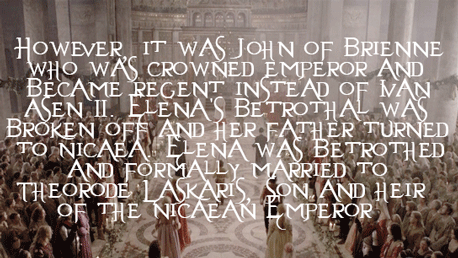

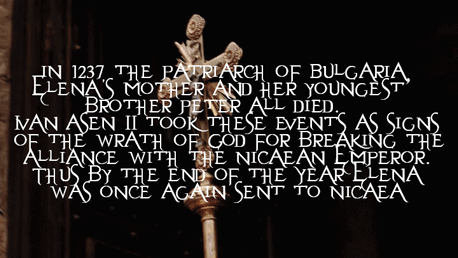
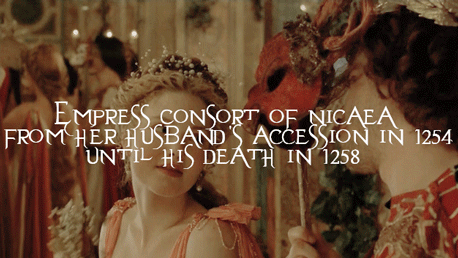

WOMEN IN BULGARIAN HISTORY :: Elena Asenina, Empress of Nicaea
Elena Asenina (also known as Elena of Bulgaria) was born in the 13th century, possibly in 1224. The daughter of tsar Ivan Asen II of Bulgaria and his second wife Anna Maria of Hungary, she was probably named after her paternal grandmother Elena.
Elena’s grandfather was Ivan Asen I, who, together with his elder brother Peter founded the Second Bulgarian Tsardom in 1185. After the two brothers were successivly assassinated, their youngest brother Kaloyan became tsar in 1197. After Kaloyan himself was assassinated 10 years later, his supporters tried to secure the throne for Ivan Asen II, however, his cousin Boril seized the throne instead and he and his brother Alexander were forced to flee to “the lands of the Russians”. Boril, however, never managed to strenghten his rule, which enabled Ivan Asen II to muster an army and return to Bulgaria, capturing the capital Turnovo and blinding his cousin Boril in 1218. Once tsar, Ivan Asen II tried to conclude alliances with the neighbouring powers through marriages - the first one being his marriage to Elena’s mother - Anna of Hungary, followed by his daughter and Elena’s older sister Maria’s marriage to Manuel Komnenos Doukas, brother of the ruler of Epirus, Emperor of Thessalonica and self-proclaimed Byzantine Emperor Theodore Komnenos Doukas.
Another advantageous marriage would be that of Elena. In 1228, the neighbouring Latin Empire’s ruler, Robert I, died, leaving the Empire to his underaged brother Baldwin II. The Latin aristocrats offered the regency to Ivan Asen II, who agreed. Elena was betrothed to the Latin Emperor to strenghten the new alliance and was most likely sent to Constantinople. However, feeling threatened by Ivan Asen II’s increasing influence, the Latins soon started secretly negotiating with the former King of Jerusalem, John of Brienne, offering him the regency instead. Once John of Brienne was ceremoniously crowned as co-Emperor in 1231 and Elena was sent back home, Ivan Asen II was furious, tearing the treaty and the union with the Catholic Roman Church (signed by his uncle Kaloyan) down.
Ivan Asen II then turned to the Nicaean Empire (founded by the Byzantines after Constantinople was occupied by the crusaders in 1204), signing a treaty with Emperor John III Doukas Vatatzes. To strenghten this alliance, Elena was betrothed to the emperor’s son, Theodore Laskaris in 1234. Ivan Asen II also sent envoys to the Ecumenical Patriarch Germanus II to start negotiations about the position of the Bulgarian Church. In the following 1235 Ivan Asen II and John III Doukas Vatatzes met to conclude a former alliance. According to George Akropolites
“Then Asen and his wife, the Hungarian Maria, and his daughter Elena came to Kaliopolis and met the Emperor there. Both did the necessery in terms of friendship. Ivan Asen did not go to Hellespont but stayed within the borders of Kaliopolis. Emperor John went to Lampsacus with his [Ivan Asen’s] wife and daughter, where Empress Irene was. There the children were married by Patriarch Germanus. It was then decided by the Emperor’s decree that the Archbishop of Turnovo, who was subordinate to Constantinople, should be named Patriarch, as the rulers thanked the Bulgarian ruler Asen for his friendship. After everything was done, Empress Irene took her son and his bride and lived in the eastern lands. Asen’s wife also returned to her lands. Emperor John and Asen took with them troops and attacked the western lands that were under the yoke of the Latins.”
This alliance, however, worried Ivan Asen II’s son-in-law’s brother, Theodore Komnenos Doukas, who hoped he would be the one to restore the Byzantine Empire. Thus Theodore invaded Bulgaria but was decisively defeated by Ivan Asen II himself in the battle of Klokotnitsa and was later captured and deposed. Epirus was now ruled by his brother Manuel, who swore fealty to his father-in-law Ivan Asen II.
Bulgarian and Latin troops unsuccessfully laid seige on Constantinople twice. The unsuccess and the death of John of Brienne (which was a possibility for Ivan Asen II to finally become regent of the Latin Empire) in 1237 made Ivan Asen II put an end to the alliance with the Nicaean Empire. Elena returned to Bulgaria.
“As his [John III Doukas Vatatzes’] son Theodore was a child - he was, as we said, 11 years old when he married princess Elena - the marriage remained formal. They were taken and educated by Empress Irene, for she was of good characted and inclined to everything good. And so the Latins’ situation was very difficult and they were humiliated by the intermarriage of the two Autocrats. King John [of Brienne], having lived a little longer, died and left the power in Constantinople to his son-in-law Baldwin and Asen, regretting, as it turned out, the treaties with Emperor John, sought a way to free his daughter from her marriage to Emperor Theodore and to marry her to another. Because as the ruler of a nation that was once subordinate to the Romans, he was afraid of a favourable turn for them. And so he was looking, as it seemed, for an excuse, although this was not a secret to those who knew the situation. He sent envoys to the Emperor and the Empress, to tell them that because they were close to Adrianopolis, he and his wife wanted to see their daughter and give her paternal embrace. They would do this and then immediately send her back to her father-in-law and her husband. Although Emperor John and Empress Irene realized what could happen, they sent Asen his daughter. They knew that if he keeps his daughter and takes her away from her lawful husband there is a God who sees everything and punishes those who break the oaths and treaties made before God. And so the Bulgarian took his daughter and left, sending those who accompanied her back. He headed for Turnovo but his daughter wept for her mother-in-law - Empress Irene - and grieved because she was separated from her husband. Then, it is said, Asen took her to sit on his saddle, hit her with [his] hand on her head and threatened to kill her if she did not silently bear what he had decided for her.” - George Akropolites
Ivan Asen II then concluded an alliance with the Latin Empire against Nicaea. Bulgarian and Latin troops laid seige to Tzurulum. Ivan Asen II was there himself, when news of the simultaneous deaths of his wife Anna Maria of Hungary, his youngest son Peter and the Patriarch reached him. He took these events as signs of the wrath of God for breaking the alliance with John III Doukas Vatatzes, abandoned the seige and sent Elena back to Nicaea at the end of 1237.
And so Elena stayed with her husband, Theodore Laskaris. The two had 6 children:
Irene - married Constantine Tikh Asen of Bulgaria
Maria - married Nikephoros I Komnenos Doukas of Epirus
Theodora - married Mathieu de Mons, baron of Veligosti
Eudoxia - first married Pietro I, Count of Ventimiglia and then Arnaud Roger, Count of Pallars-Subirà
a daughter whose name is unknown - married Yakov Svetoslav, a Bulgarian despot
John IV Doukas Laskaris - Emperor of Nicaea
In 1254, after John III Doukas Vatatzes’ death, Theodore Laskaris became Emperor and thus Elena became Empress of Nicaea. 4 years later, in 1258, Theodore II Laskaris died and Elena’s son John became Emperor.
The date of Elena’s death is not known. It is believed that she was alive when her son was blinded on the orders of Michael VIII Palaiologos on his eleventh birthday. It is possible she died shortly afterwards.
#women in history#women in bulgarian history#elena asenina#helena asenina#elena of bulgaria#helena of bulgaria#nicaean empress#empress of nicaea#historyedit#perioddramaedit#myedit#fancast#holliday grainger#the borgias#13th century#insteresting women#unknown women#bulgarian history#european history#medieval#medieval history#long live the queue
144 notes
·
View notes
Photo

Today we also celebrate the Holy Queen Theodora of Arta. Theodora was born in Thessaloniki sometime between 1210 and 1216, and married Michael II Komnenos Doukas, the ruler of Epirus and Thessaly shortly after his accession in 1231, while still a child. Despite her being pregnant with Michael's son Nikephoros, she was soon banished from the court by her husband, who preferred to live with his mistress. Living in poverty, she endured her hardship without complaint, sheltered by a priest from the village of Prinista. Her exile lasted for five years, after which Michael repented and called her back to him. The couple thereafter lived together. As consort of Epirus, Theodora is reported to have favoured closer ties with Epirus' traditional rival for the succession of the Byzantine imperial heritage, the Empire of Nicaea. She is also recorded by the contemporary historian George Akropolites as accompanying her son Nikephoros for his betrothal and later his marriage to Maria, the daughter of the Nicaean emperor Theodore II Laskaris (r. 1254–1258). The rapprochement brought about a settlement of the two realms' ecclesiastical disputes and led to the conferment of the title of despotes on Michael, but did not last long. Theodora also founded the convent of St. George in the Epirote capital, Arta, where she retired after Michael's death, and where she was buried. It later became known as the Church of St. Theodora, and her tomb became the site of pilgrimage, as many miracles have been attributed to it. May she intercede for us always + Source: https://en.m.wikipedia.org/wiki/Theodora_of_Arta (at Arta, Greece) https://www.instagram.com/p/CMP3iDWpGbk/?igshid=fa0nu88n3vxw
5 notes
·
View notes